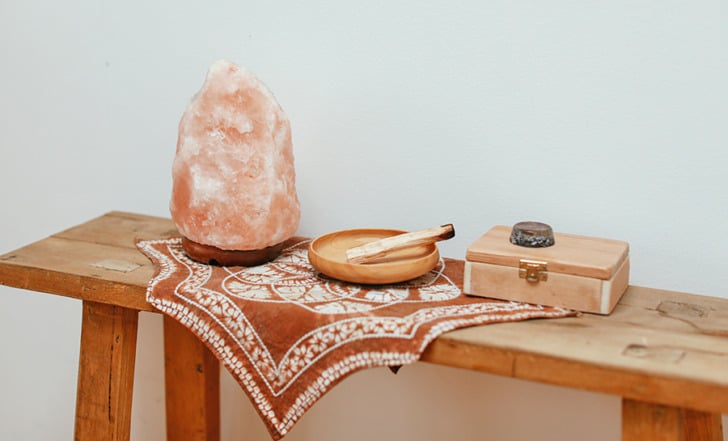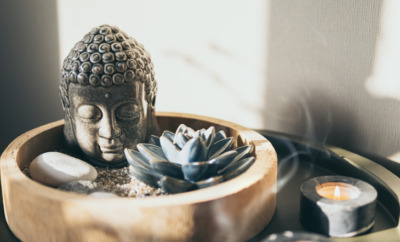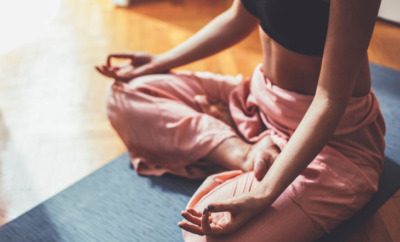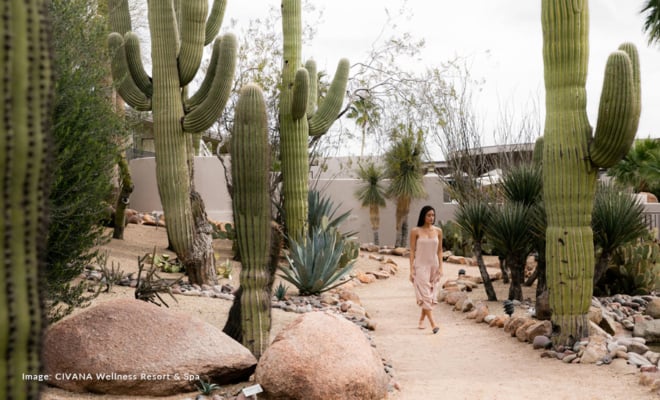7 Psychology-Based Hacks to Create the Ultimate Sacred Space

psychology sacred space featured image 2
“Each place is the right place… the place where I now am can be a sacred space.” – Ravi Ravindra
Amidst the hustle and bustle of our modern lives, carving out a sacred place in our home can help us feel cozy, safe, and open – open to new thoughts, open to new bends in our yoga practice, open to the truths that await us in the stillness.
Call it your personal yoga studio, your zen den, sacred space, or even your own miniature spa. When done right, it’s a quiet spot for us to relax into the peace of the present moment.
“Sacred space is another way of saying with intention,” says S. Kelley Harrell. When we’re seeking to craft a meditation nest conducive to self-growth and happiness, the intentional decisions we make in terms of decor, altar objects, and other design choices can help us raise the room’s vibration.
Thus, creating your zen den, when done consciously and intentionally, will help you reap the maximum benefits for your physical, emotional and spiritual wellbeing.
Science and psychology offer us 7 tricks for amping up the power of our sacred space:
1. Find a spot just for you
Our sacred space should be exclusively reserved for our zen practices. Choose a secluded area that’s away from the rest of the house. Perhaps it’s a closet just big enough for you to sit in lotus pose, or maybe it’s an entire spare room.
Wherever you choose to create your yogic space, avoid the temptation to share it with storage or office paperwork or any sort of clutter. These distracting elements bring the energy of the rest of our lives into the space, when we really only want to devote the space to the energy of yoga or meditation, stillness, and peace.
2. Paint with all the colors of the wind
Chromotherapy, also known as color therapy, is the science of how different shades and hues affect our emotions. Psychologists have found that certain colors can evoke specific feelings within us, and even affect our physical body. For example, psychologist Sally Augustin told Psychology Today that warm colors will make us think a room is physically warmer than it actually is!
Channel that power into the zen den’s design. On a small scale, a piece of art, a coffee mug or a throw rug can bring a pop of color into a space. If you’re feeling industrious, break out the paint cans and cover an entire wall or two. The right color depends on the type of feelings you want to manifest.
Purple symbolizes spirituality, prosperity and wisdom. Blue creates a sense of serenity, truth and focused calmness. Green makes us think of growth, health and harmony. And gray represents timelessness, neutrality and peace.
3. Outfit naturally
When selecting furniture and decor for your zen den, pick items that add good vibes but not unhealthy chemicals. For example, some mass-produced furniture, yoga gear and carpets are laden with formaldehyde and volatile compounds.
Aim for yoga mats, meditation cushions, furniture and other items made with natural materials like organic cotton, recycled cork or bamboo and unvarnished wood.
4. Accent with scents
The cells in our nose responsible for picking up a scent connect directly with the parts of our brain that control memories and emotions. It’s no wonder that when we smell certain scents, we’re instantly transported to a memory or past experience.
Thus, essential oils can play a significant role in our mental, physical and emotional health, according to the University of Maryland Medical Center. Using incense, essential oils, potpourri or dried herbs in our meditation space can help us connect with the emotions and memories that we want.
Rose and lavender scents help release stress or anxiety. Sandalwood can calm chronic worry and overthinking. And lemon or clary sage may help with depression and grief.
5. Lend an ear
“Music is what feelings sound like,” says psychologist Cortney S. Warren. Multiple studies have shown how music can change how we feel and think. Music can even affect totally unrelated things, like how we perceive a photo.
In a recent University of London study, participants listened to either sad or happy music. After, they were shown a photo of someone’s happy, sad or neutral face. Sad music made the sad faces appear sadder, while happy music made happy, smiling faces look even happier. The same held true for neutral faces.
Music is what feelings sound like.
What do you want to feel when we look around our sacred space? Incorporate music into the sacred space that matches the vibe you’re trying to instill. For example, if you want to feel energized for your morning yoga practice, a fast-paced mantra recording can help. Or, if you’d like to unwind or meditate, soothing classical music or the hum of a Tibetan singing bowl can ease your mind.
6. Reach out and touch nature
The American Society for Horticultural Science reviewed dozens of scientific studies and found that bringing a bit of Mother Nature indoors in the form of houseplants helps us feel more positive, combats tension and stress, and may even improve our physical health.
Houseplants also work like all-natural air purifiers and filter out common indoor toxins like formaldahyde and benzene, cleansing and oxygenating our meditation space.
Air-purifying plants that do well indoors – even in tiny apartments – include English ivy, gerbera daisies, peace lilies and aloe vera.
7. Finish off with sacred objects
Just as we should remove clutter that distracts us from the intention of our sacred space – papers that need to be organized, our to-do list, clothes that need folding – we can also add items that remind us of the mindset and lifestyle we’re trying to manifest.
Perhaps it’s crystals or gem stones that represent our chakras, or figurines of gods or goddesses that embody the spiritual principles we live by, or a printout of our favorite inspirational quote or mantra. As we sit in our zen den, we can focus our thoughts on these altar props and sacred objects any time our mind starts to wander.
“Be here now,” Ram Dass and many other teachers tell us. Being here, right now, fully and completely in the present, isn’t always easy. When we slip into our homemade sanctuary, surrounded by the right colors, smells and props, we can soothe the chatter in our mind and find our true selves awaiting us in the peaceful stillness.


This Month's Letter
From the Editor
Monthly motivation and food for
thought from our founder.






























